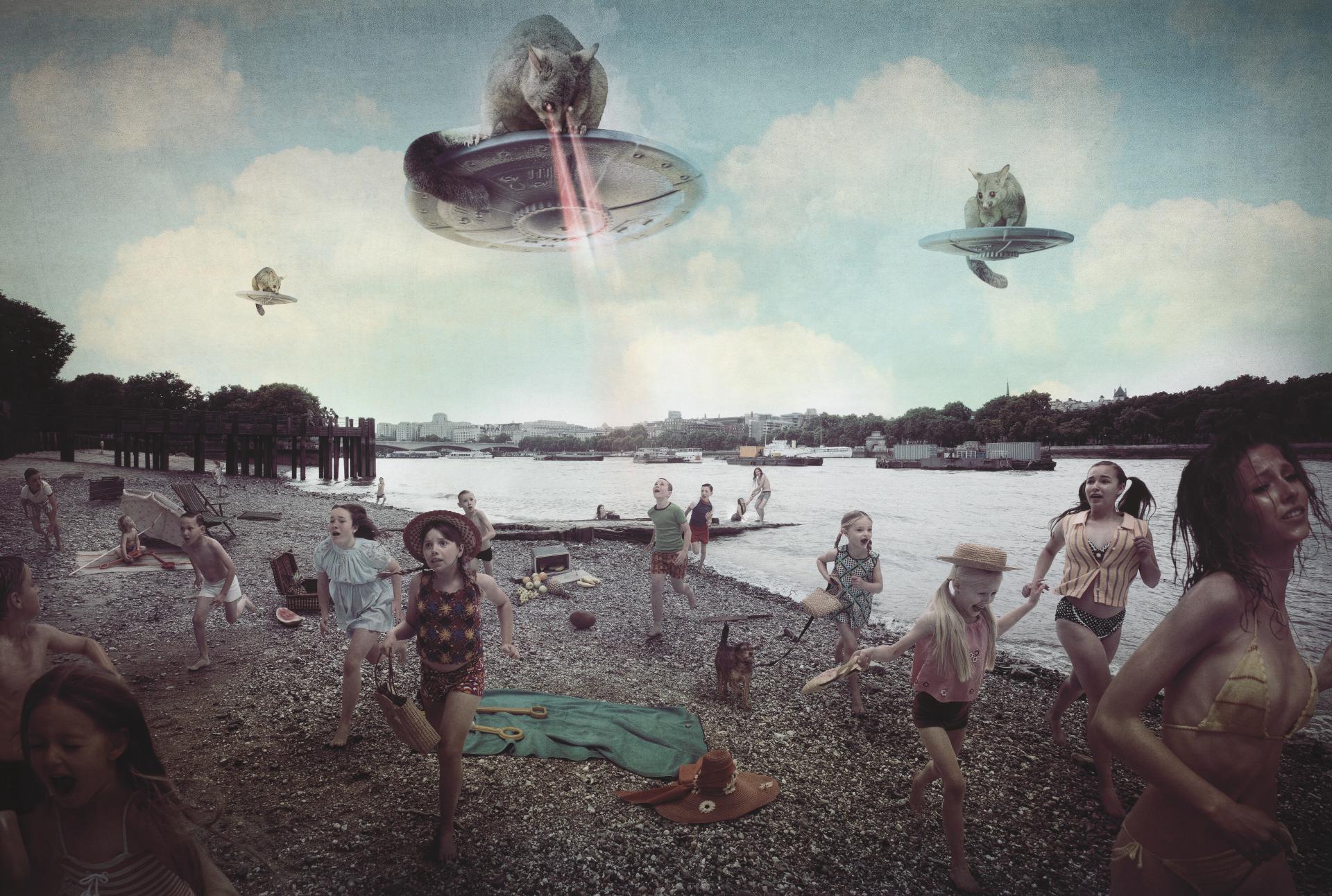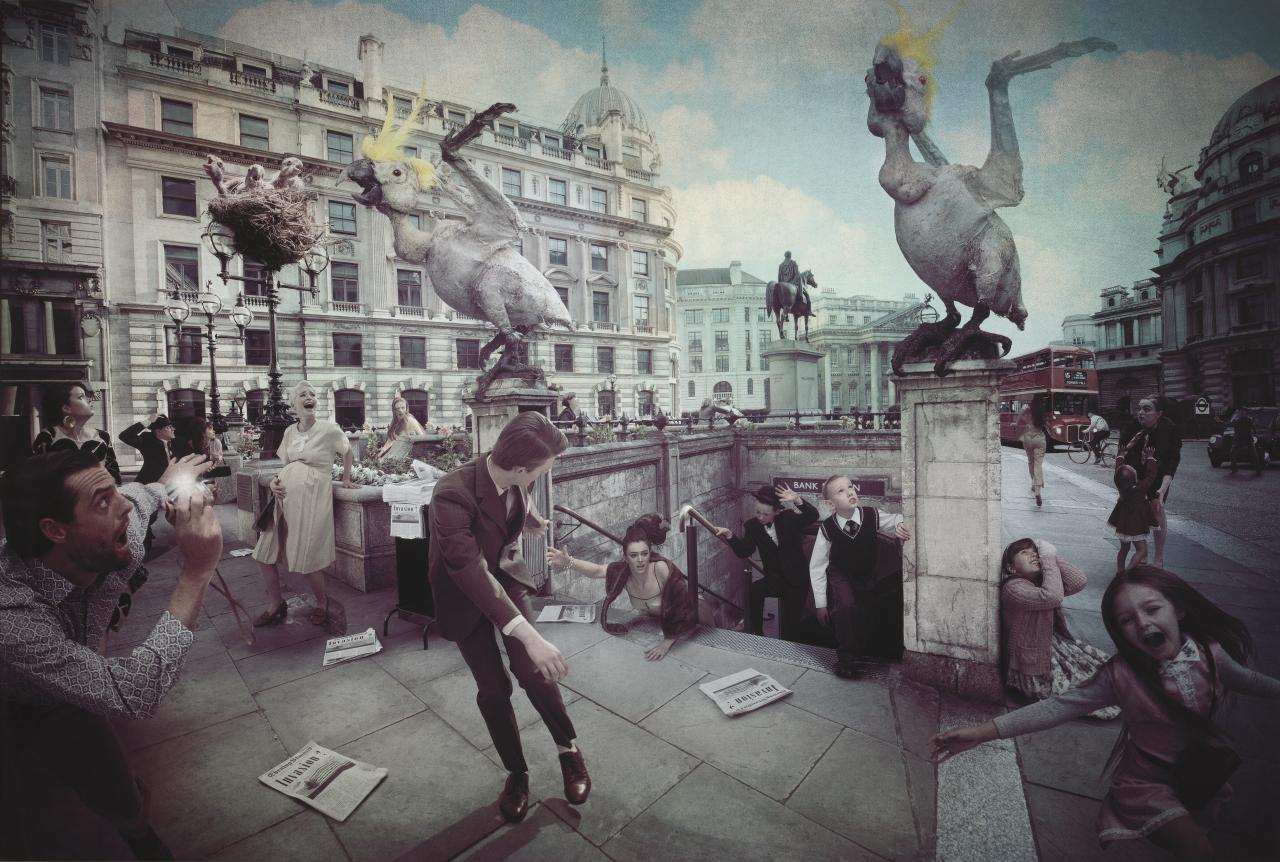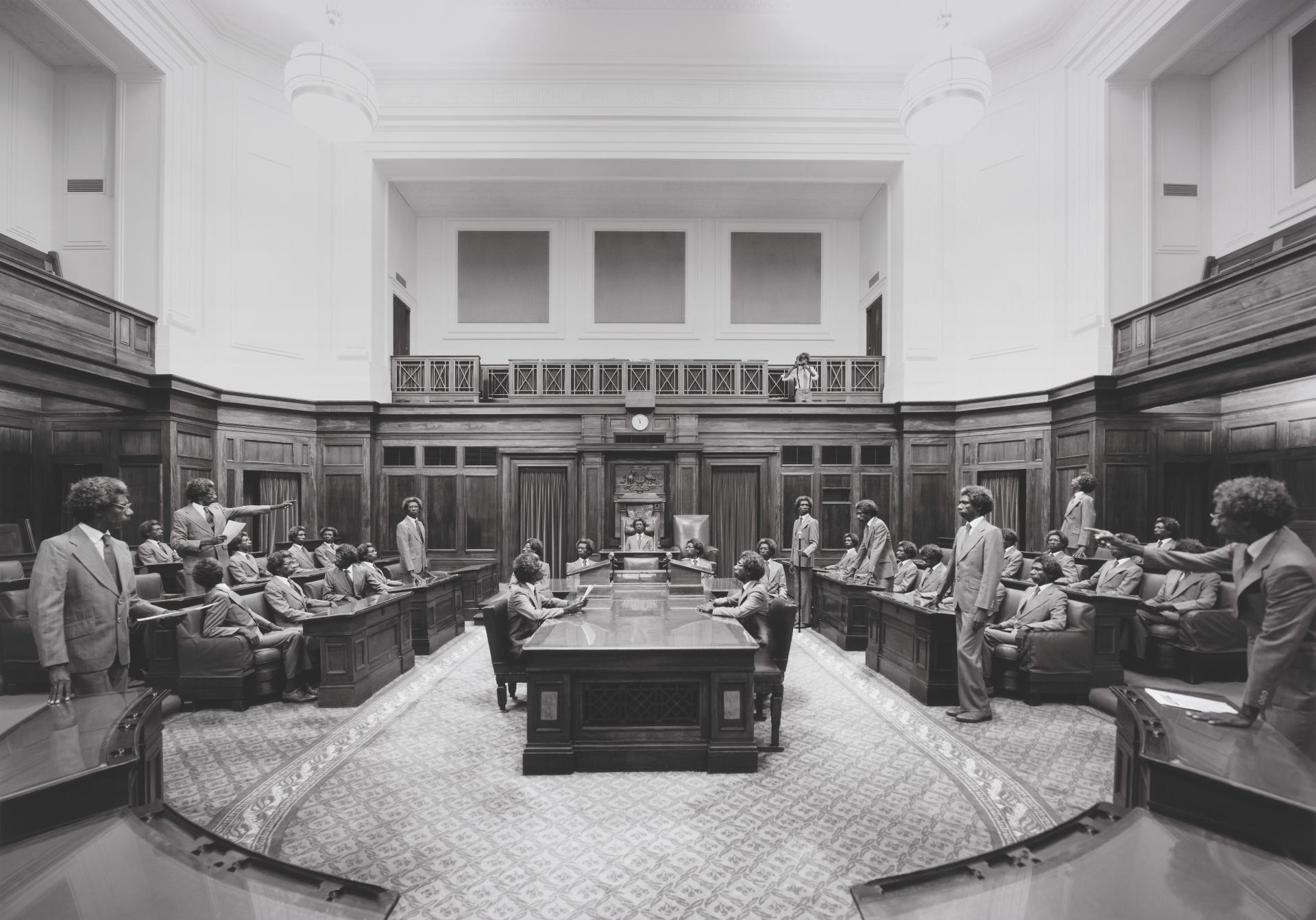Michael Cook’s Invasion
Rex Butler
There are three of them in the collection of the National Gallery of Victoria. In one, giant possums on top of spaceships fire down on a group of children running screaming along a pebbly overcast beach. In another, a kangaroo appears to cast laser beams from its eyes, hitting a man in a suit who reels back arms out, while a terrified mother and child in a pram look on in horror. And in the last and undoubtedly strangest, giant featherless yellow-crested cockatoos sit atop pedestals on either side of a tube station entrance squawking at commuters as they come up the stairs, while next to them their chicks are propped up high in a nest on a streetlamp, and what looks like a statue of a rider on a horse turns away in the background.

They are three large inkjet photographs from Bidjara man Michael Cook’s Invasion series of 2018, titled respectively Invasion, UFO Possums, Invasion, Kangaroo, and Invasion, Giant Birds.
What do they remind me of? Maybe it’s all the science-fiction I read as a young boy, but it’s undoubtedly H. G. Wells’s 1898 classic The War of the Worlds. (Lots has been written and said about Cook’s series, but as far as I can tell the connection between the two has never been made.)
The War of the Worlds, as everybody knows by now from the 2005 film version by Steven Spielberg, starring Tom Cruise and Dakota Fanning, is the story of Martians who arrive one day in spaceships, mercilessly killing humans and looking like they will successfully occupy the earth and colonise the remaining population, until they are brought down not by any human resistance but by the smallest of small things: a humble microbe or bacterium often said to be the common cold. In Wells’s reflective words from towards the end of the novel:
These germs of disease have taken toll of humanity since the beginning of things—taken toll of our prehuman ancestors since life began here. But by virtue of this natural selection of our kind we have developed resisting power … But there are no bacteria in Mars, and directly these invaders arrived, directly they drank and fed, our microscopic allies began to work their overthrow.
Of course, it is an appropriate revenge for the Martians’ hubris and disdain, the way they feel no compassion for the humans they kill and conquer because of their innate superiority to them—at one point Wells writes, summarising the Martians’ feelings towards humans, “We men, the creatures who inhabit this earth, must be to them at least as alien and lowly as are the monkeys and lemurs to us”—the fact that they are defeated by the lowest and seemingly least evolutionally advanced of all: the ordinary everyday bug or germ.

And here on earth the Martians remain, a permanent reminder of the fate so narrowly avoided. In almost the concluding shot of Spielberg’s film, just before Cruise’s family is reunited, made strong again by the challenge just faced, one of the shot-down spaceships emits a ghastly torrent of red bile before a thin translucent arm reaches out of the door and a Martian takes its last laboured breath before closing its eyes.
Wells’s novel is one of the foundational works of science-fiction or fantasy, inaugurating the whole alien invasion genre. It is the basis of an early 1953 film directed by Byron Haskin, it has been turned into a play for the social media age by Isley Lynn, and most famously before Spielberg it was the subject of an astonishing 1938 radio play, scripted by Howard Koch and voiced by Orson Welles, which reimagines Wells’s story as though a radio bulletin of an actual alien invasion taking place in real time, which led to mass hysteria in the audience listening to it live throughout much of the east coast of America the evening it was broadcast. (And the entire episode was the subject of a later 1975 television movie, The Night that Panicked America, which is well worth watching.)
But what is only sometimes remembered, even though Wells makes it clear in the opening chapter of his novel, is that The War of the Worlds is inspired by Wells’s reading of the invasion of Tasmania in the newspapers and imagining what it would be like being the Palawa looking on as utterly unimaginable other people arrived and started walking up the beach, navy hats awry and rifles in hand. These are Wells’s words from “The Coming of the Martians” :
The Tasmanians, in spite of their human likeness, were entirely swept out of existence in a war of extermination waged by European immigrants in the space of fifty years. Are we such apostles of mercy as to complain if the Martians warred in the same spirit?

There’s another book that starts with a reflection upon Wells taking inspiration from the massacre of the Palawa peoples. It is Noel Pearson’s 2015 The War of the Worlds, which begins with an admission of how much the novel meant to him as a young man, his subsequent shock at realising the historical events on which it is based and the fact that he now shares his youthful enthusiasm by reading it together with his young son.
But Pearson also makes the point, as have numerous other commentators on the book, that for all the brilliance of Wells’s novel and the redemptive revenge it wreaks upon the Martians for their act of invasion, Wells held a number of derogatory attitudes towards Aboriginal people, and even in the novel itself the Martians are in fact seen as having every right to take over and colonise the lesser humans: “And before we judge of them too harshly we must remember what ruthless and utter destruction our own species has wrought, not only upon such animals as the vanished bison and the dodo, but upon its own inferior races.” For all of his prescience and imagining of different futures, Wells also shared any number of the values of his time, apparently up to and including eugenics and forms of social Darwinism (and, of course, Tasmanian Aboriginal people were not entirely “vanished”).
But Cook—and in a way Wells—makes us imagine a world in which the roles are reversed. Invasion is set in 1960s London—we see the clothes, the Thames, tube stations, the home of the Lord Mayor and even the statue of the Duke of Wellington on a horse—and the scenario played out (he does not quite have the courage to have Palawa people manning the spaceships) is like it would be if one day Aboriginal aliens suddenly arrived from outer space and started terrorising the citizens of Earth. In other words, he lets us experience for a moment what it would be like being a Palawa in 1824 watching the boats arrive from outer space. What would become of your world and everything you had previously lived by?
Some scholars call Wells’s War of the Worlds a “satire,” relating it back to that tradition started by Jonathan Swift’s Gulliver’s Travels. And obviously the era of European colonisation was the time of satire, with Europe’s encounter with different cultures allowing it to imagine seeing the world through “other” eyes.

But satire has also been employed by any number of Indigenous artists to allow us to imagine the world through their eyes. One of my favourites is Cook’s 2014 series Majority Rule, which portrays an Australia exclusively inhabited by Aboriginal people, from a bus full of businessmen going off to work to barristers arguing in court, to the Senate of Federal Parliament full of black politicians on both sides. (Actually my favourite, and perhaps the purest satire in this sense, scripted I believe by a white Australian, is the 1986 short film BabaKiueria, which begins with a group of stereotypically lazy white Australians at the beach enjoying a barbeque, before a group of Aboriginal colonisers arrive by boat and step across the last few metres of foamy water to plant an Aboriginal flag in the sand. Matching this there is also Gordon Bennett’s Notes to Basquiat: Death of Irony (2002), which reimagines E. Phillip Fox’s mythologising Captain Cook at Botany Bay, 1770 (1902) as remade by Jean-Michel Basquiat, with a skeletal graffitiesque ghost-like figure confronting Cook at his moment of triumph.)
Cook apparently once said that the question raised by his Majority Rule series was “What if governments had been able to see from an Aboriginal perspective, where would Aboriginal people be today?,” and it has even been suggested that Malcolm Turnbull kept one of Cook’s works from the series on the wall of his office in Parliament House while he was Prime Minister.
Sometimes art lets us see the world in a different way, and it can even embody attitudes that go beyond—and are perhaps even the inversion of—those held by the artist themself. And, as Noel Pearson testifies, it can affect you deeply and forever, even when you no longer entirely believe in the artist or what the artist believes in.
No matter what happens today or any other day, Cook’s Invasion and Majority Rule will still be with us, reminding us of another possible world and another possible future. It might only be science fiction or satire, but one day the Martians will come down to us from outer space like our own guilty consciences or better angels. But perhaps this time not to kill us or take us over, but to save us. Tomorrow, if not today, might be the day the earth stands still.
Rex Butler teaches Art History in the Faculty of Art Design and Architecture at Monash University.


